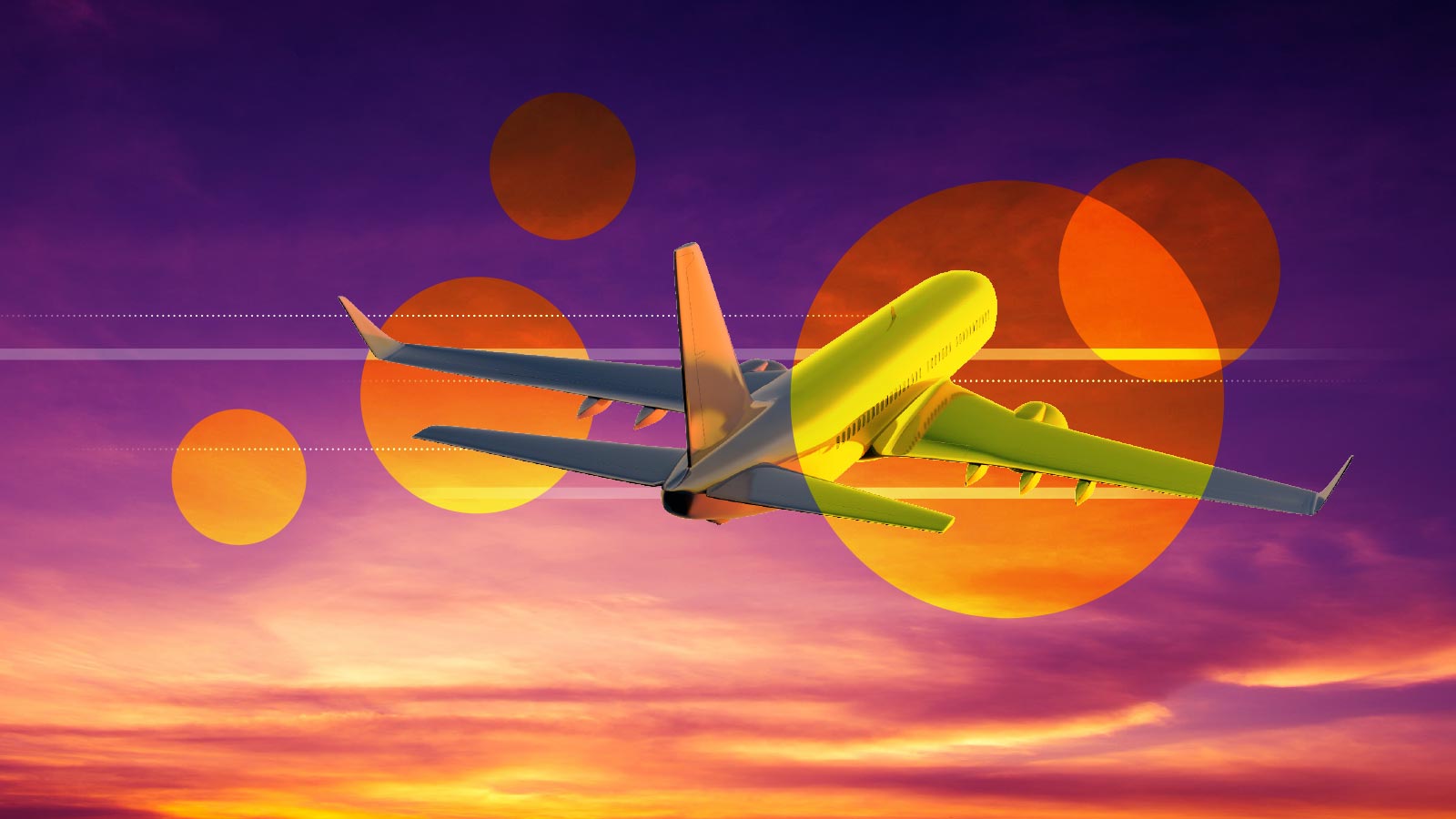Stay Up to Date
Submit your email address to receive the latest industry and Aerospace America news.
Aerospace America publishes a rice variety of opinions relevant to the future of aerospace. The views expressed are those of the author(s) and do not necessarily reflect those of our publisher, AIAA.
The aviation industry is making progress toward its goal of reaching net-zero carbon emissions by 2050, but there are growing concerns it will fall behind as the political winds shift.
At the 2021 annual general meeting of the International Air Transport Association, IATA member airlines passed a resolution committing them to the goal. At the time, the industry noted that achieving net-zero would require the coordinated efforts of the entire industry — from airlines to airports to air navigation service providers and manufacturers — as well as significant government policy and financial support. A year later, this goal was reaffirmed by the 2,500 delegates from 184 member states and 57 organizations of the International Civil Aviation Organization.
The Waypoint 2050 report, published by the Air Transport Action Group in 2021, laid out paths to reach net-zero by 2050 with a combination of measures. These included introducing new technologies that would enter service in the 2035-2040 timeframe, making operational and infrastructure improvements, warranting market-based offsets leveraging other sectors, and relying more on sustainable aviation fuel, or SAF. Since publication, the industry has added replacement of the fleet with more fuel-efficient airliners as a fifth measure.
But this flagship goal is now in peril due to climate-skeptic policies, including those of U.S. President Donald Trump. The election of leaders favoring fossil fuels and recent regulatory rollbacks is “obviously a setback” and “does imperil success on the 2050 horizon,” Marie Owens Thomsen, IATA’s senior vice president for sustainability, said in June at IATA’s industry conference in India.
“But I don’t think it’s going to halt or reverse progress. I think it will just slow progress,” she added.
IATA has also warned that the industry is falling behind on a nearer-term goal related to the net-zero target: The European Commission decreed a mandatory usage of 6% SAF for airlines operating in the European Union by 2030, but IATA says that is now unreachable.
A huge issue is that SAF producers are not ramping up production to meet the scale of the industry’s demand, producing only about 1% of global jet fuel demand today. At these rates, SAF is significantly more expensive than conventional jet fuel, and major oil companies haven’t invested sufficiently in SAF production facilities, hindering market growth and keeping SAF prices uncompetitive. For example, oil giant BP announced in February that it would be join Shell and other energy companies by investing less in renewables. CEO Murray Auchincloss said the company had gone “too far, too fast” in transitioning away from fossil fuels, BBC reported, and called the faith in green energy “misplaced.”
At the government level, Trump’s signature legislative package signed last month took aim at assistance and rebates for renewable energy projects. However, the law also extended the Clean Fuel Production Credit through 2031. Known as 45Z, this credit applies to SAF and non-SAF biofuels and provides a per-gallon tax credit dependent upon the emissions factor of the fuel. The financial competitor to SAF remains the low cost of oil, which would need to top $80 a barrel for SAF to remain cost competitive.
Despite these challenges, there have also been signs of progress toward the decarbonization goal. Delta Air Lines increased its capacity by 5% last year compared to 2019 but used less jet fuel, a first for the airline. It saved 44 million gallons of jet fuel and roughly $110 million. Delta credited that to flight improvements, including more efficient routes.
Also on the operations side, a new air traffic control system announced by the FAA is meant to simplify routing and modernize the airspace to provide more efficient flights. Airports are also moving to bolster sustainability. Los Angeles International Airport exceeded its 2025 goal to have a 15% reduction in energy use per passenger and met the 2023 aim to have a 20% zero emissions bus fleet. Also, Denver International Airport is home to one of the largest and most diversified solar energy programs of any airport in the world.
Fleet renewal is an integral part of many airlines’ sustainability and economic plans. Newer aircraft models are designed with more advanced technology, which directly translates to reduced fuel consumption and lower carbon emissions. For example, the Airbus A320neo is estimated to be 15-20% more fuel-efficient than its predecessor, while the Boeing 787 Dreamliner and Airbus A350 can offer up to 25% better fuel efficiency than previous models.
Fuel is a major operating expense for airlines, so transitioning to these newer, more fuel-efficient designs can help reduce their operating costs, making them more financially and environmentally sustainable. American Airlines, for example, operates the youngest mainline fleet in the U.S. and has improved fuel efficiency by 9.8% compared with 2013, based on fuel burn per available seat mile, avoiding 22.9 million metric tons of CO2.
There is also progress on the technology front. Several entities are continuing to pursue electrification, new engine configurations, investigations of hydrogen as a fuel, and unconventional aircraft configurations. For instance, California startup JetZero, in conjunction with the U.S. Air Force, is developing a blended-wing cargo demonstrator that the company also intends to market as an efficient airliner, while ZeroAvia has signed agreements with multiple airlines to retrofit their existing aircraft with the company’s hydrogen-electric engines. Pratt & Whitney, in conjunction with the U.S. Department of Energy, last year tested its Hydrogen Steam Injected Intercooled Turbine Engine concept, which reduces NOx emissions normally associated with burning carbon-free hydrogen in a turbine engine.
Yet, these new technologies will not be making any significant impact on carbon emissions early enough to impact the 2050 goals. And technology projects that were slated to be in service by 2035 have seen recent setbacks. Airbus has revised the timeline for its ZEROe hydrogen aircraft, which would have contributed to meeting the total emissions target. The airframer is also working on an A320 family short-to-medium-range replacement but has deferred service entry to the second half of the next decade. Boeing in April announced it was pausing work on the X-66A transonic truss-braced wing demonstrator it was developing with NASA and industry. The French-Italian manufacturer ATR has delayed the launch of a hybrid-electric version of its ATR 72 turboprops, known as EVO, by at least five years. Alexis Vidal, ATR’s senior vice president commercial, told Flight Global in February that the work with its engine partners led the airframer to conclude that “with the maturity of the technologies we cannot commit to an imminent launch decision. We have to adapt and face reality about what’s feasible and what’s not.”
Such delays may be discouraging to net-zero proponents. Even so, short-term economics will drive efficiencies and development of lower-cost substitutions over the next decades. But it will be up to consumers to influence government mandates, support environmental issues and, in the end, pay for the transition to a cleaner aviation future.
The 2050 target was established to accelerate the technology to support the aviation sustainability transition, but even if it isn’t met that year, the transition to a cleaner aviation future is clear.
About Amanda Simpson
Amanda Simpson is a consultant, a former U.S. deputy assistant secretary of defense for operational energy, and a former head of research and technology at Airbus Americas, where she led sustainability efforts. An AIAA fellow, she’s a licensed pilot and certified flight instructor.
Related Posts
Stay Up to Date
Submit your email address to receive the latest industry and Aerospace America news.




